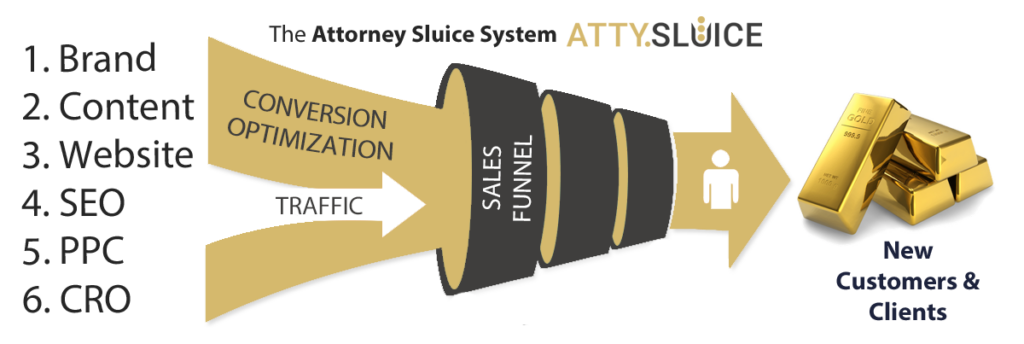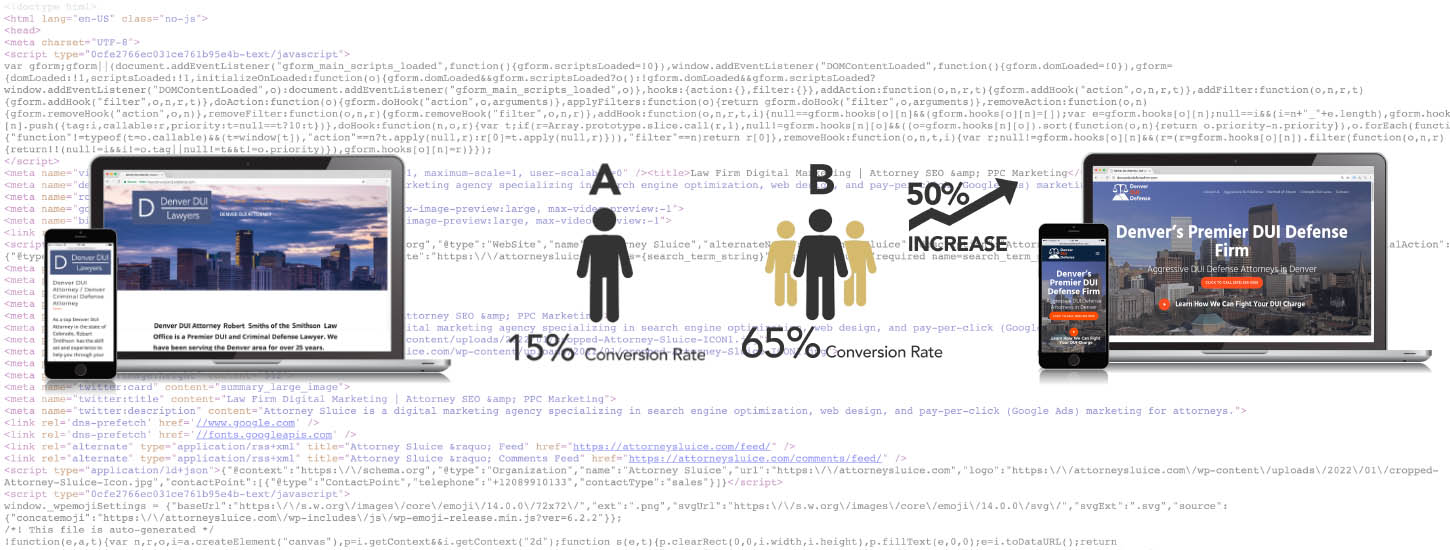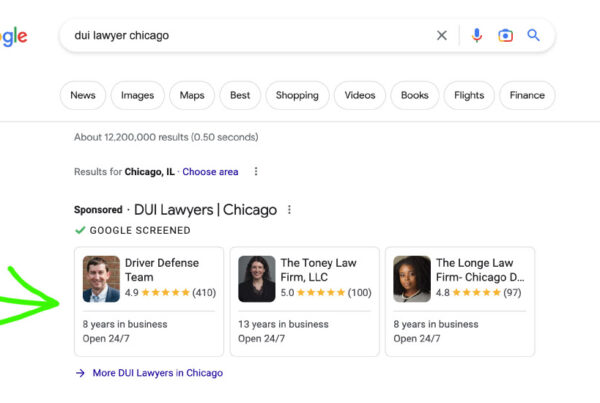If you aren’t seeing the success from your digital marketing efforts that you want, it’s likely because you are not utilizing conversion rate optimization.
Conversion rate optimization, or CRO for short, is by far the most overlooked piece of a law firm’s digital marketing strategy.
Getting potential clients to your law firm’s website is only half the battle. Once they’re there what action do you want them to take?
- Call to Schedule a Consultation
- Fill out a contact form
- Sign up for an email newsletter
- Download an ebook, etc.
- Watch a video
To successfully market your legal practice online, you must take these things into consideration.
What is Conversion Rate Optimization?
Regarding internet marketing, conversion rate optimization (also called conversion optimization, lead conversion, or just CRO) is the process of increasing website leads and sales by creating a more seamless experience for a website or landing page visitor without having to spend more money on attracting additional internet traffic.
Whatever action you want your website visitors to take, this action is what you want to measure and what you are looking to optimize (improve).
It’s the process of experimenting with website design and content variations to determine which ads, layouts, sales copy, offers, videos, and images will convert prospects into paying clients.

At its most fundamental, CRO means figuring out what potential clients are looking for when they arrive at your site and then presenting that to them.
A well-thought-out CRO strategy enables you to monitor and analyze the performance of your digital marketing efforts, allowing you to optimize and adapt your approach as needed. Regularly tracking key metrics, such as visitor demographics, engagement, and conversion rates helps you identify areas of improvement and capitalize on successful tactics.
How Conversion Rate Optimization Works
Conversion rate optimization shares many of its basic principles with traditional direct response marketing (think mail, radio, TV, and print ad campaigns), which have been around for almost 100 years. Like direct response marketing, modern day conversion rate optimization utilizes human psychology, A/B split-testing, call tracking, and audience testing to optimize your website. Some test methods, such as split testing (also called A/B testing) enables you to monitor which headlines, images, and content help to convert more of your website visitors into new clients.
It’s important to understand that conversion rate optimization is also about getting more of the right kind of website traffic (highly targeted), not just blindly optimizing the conversion rate of a given page or campaign.
Gathering, analyzing, and testing visitor data is key to optimizing your website and landing pages, along with developing a strong marketing approach.
It’s amazing how many attorney’s websites don’t employ even the most basic of CRO tactics. This opens the door to a huge opportunity for those that do.

Why Conversion Rate Optimization is Important to the Success of a Law Firm’s Digital Marketing Efforts
Reason 1: Digital marketing is getting more expensive and competitive.
Throwing more money at it is not the answer, especially if there are problems in your current conversion funnel that need to be addressed. And, if you’re marketing your personal injury law firm, these keywords are some of the most expensive out there, in some markets upwards of $100+ per click. If you’re not focused on conversions, you can burn through a large advertising budget pretty quickly with little to nothing to show for it.
By playing chess, not checkers, you can gain a massive advantage over your competition by implementing even the simplest of CRO tactics into your current marketing strategy.
Reason 2: It lowers your cost per acquisition (CPA).
Higher conversion rates = better ROI.
In fact, doubling your conversion rate means halving your cost-per-acquisition (how much each new client costs you to acquire). This is almost always more cost effective than getting more website visitors.
Reason 3: It gives you more money to spend on additional acquisition.
More profit means extra money to spend on acquiring even more clients, allowing you to start growing your law firm at the pace that you want. Plus, you’ll know exactly where to spend it because you now know which of your marketing channels are bringing in your best new clients.
Reason 4: It provides a big competitive advantage.
Many attorneys neglect CRO, focusing only on driving traffic to their website. By implementing CRO, you can gain a significant edge over competitors by making your digital marketing efforts more effective. They’ll spend more and get less, while you can now spend less and get more.
Key Metrics to Conversion Rate Optimization
Sales Copy
What problem is your potential client trying to solve? Does the information presented on your website speak directly to this problem in a compelling way? It should tell them clearly and directly exactly why you are the solution to their legal problem.
Look & Feel
Are your graphics relevant, well-placed, and unique? Or are they distracting and boring? Do you have a lot of unnecessary or misplaced text? Does the website project the image you want people to have of your law firm?
Credibility
Does your website lead potential clients to believe that you have the experience and credentials to solve their legal problem? Your website should feature your experience, certifications, awards, client success stories, and past client reviews and testimonials.
Call to Action
Is your call to action (phone number, contact form, etc.) clear and easy to find? Are you considering mobile visitors (i.e., do you have a “click to call” button on mobile devices)?
Conversion Rate Optimization Is:
- A structured and systematic approach to improving the performance of your website.
- Informed by insights, specifically website traffic analytics.
- Defined by your business’s unique objectives and goals (key performance indicators or KPIs).
Conversion Rate Optimization Is Not:
- Based on guesses, hunches, or what everyone else is doing.
- Blindly changing the color of buttons and images on your site.
- About getting as many users as possible, regardless of quality or engagement.
How Attorneys Can Leverage CRO in Their Digital Marketing Efforts
- Optimize your website for search engines. This means making sure that your website is easy to find and navigate, and that it contains relevant content that will attract visitors who are interested in your legal services.
- Create effective landing pages. Landing pages are the pages that visitors land on after clicking on an online ad or sometimes a search result. Effective landing pages are clear, concise, and persuasive. They encourage prospective clients to take the desired action.
- Use A/B testing. A/B testing is a method of testing two different versions of a website or landing page to see which one performs better. This can be used to test different headlines, calls to action, or other elements of a website to see what resonates best with your potential clients.
- Track your results. This is the most important step and unbelievably often the most overlooked. You cannot optimize for conversions if you don’t know where they are coming from. This is the only way to know what is working and what is not. You can use free tools such as Google Analytics to monitor and track your website traffic.
You can also use paid tools such as CallRail to more accurately track where your phone calls are coming from.

- Make sure your website is mobile-friendly. Most people are now using their phones to access the internet. It’s important to make sure that your website looks good and functions properly on mobile devices.
- Use clear and concise language. Your website should be easy to read and understand. Avoid using jargon or legal terms that your visitors may not be familiar with.
- Highlight your strengths. What makes your law firm different from the competition? What are your areas of expertise? Be sure to highlight these things on your website.
- Special offers such as a free consultation. This is a great way to get potential clients in the door and learn more about their needs.
- Follow up with leads. Don’t just wait for potential clients to contact you. Reach out to them and let them know that you are interested in helping them.
Conclusion
In summary, CRO can be a powerful tool for attorneys to increase their new client acquisition and improve ROI from digital marketing while gaining a major advantage over their competitors.
By implementing CRO strategies like A/B testing, landing page optimization, mobile optimization, and analytics tracking, attorneys can increase the number of leads and clients they generate from their website, which can lead to increased revenue and growth for their law firm.
About the Author
Chris is a legal marketing consultant who has been helping attorneys and law firms grow their revenue and scale their legal practices for the past 13 years. His areas of expertise are in content marketing, search engine optimization (SEO), pay-per-click (PPC), digital PR & branding, and conversion rate optimization (CRO).








